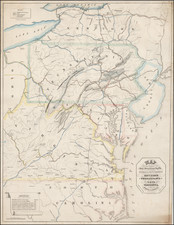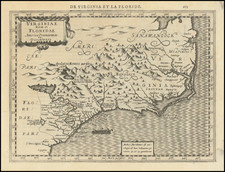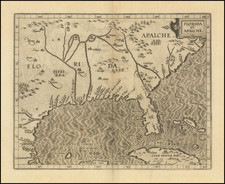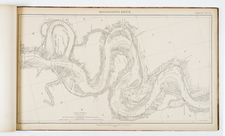A finely executed manuscript map showing the opposing trench lines at the Siege of Petersburg, 1864-5, the final major battle of the U.S. Civil War, drafted on the verso of a rare printed map of the Virginia-Maryland battle theatre.
The front of the present sheet features a rare first edition of Alexander Dallas Bache's map of eastern Virginia (1862). By the time the map was issued, the region had already become one of the major theaters in the war, following the two Battles of Bull Run (1861). Virginia was home to Richmond, the capital of the Confederate States of Ameirca. This detailed map shows all of the major cities, rivers and railways, the information of primary importance for the cartography of military movement. On the verso, is a fantastic original manuscript battle survey. Paper was often in short supply in the active operational theaters during the war and it was not unusual for any sheet of paper to be applied to multiple uses.
Rickett's Civil War Manuscript Map of the Siege of Petersburg
On the verso of the Bache map is a detailed contempory manuscript map of the Siege of Petersburg, Virginia, the final major battle of the U.S. Civil War (June 9, 1864 to March 25, 1865). In the spring of 1864, in the face of omnipresent Union pressure, the Confederate forces were in retreat all across the South. General Robert E. Lee's legendary Army of Northern Virginia, badly short of supplies and outnumbered by General Ulysses S. Grant's Union forces, was compelled to mount a desperate bid to save the Confederate capital Richmond and the important town of Petersburg (located 30 miles to the south), from falling onto enemy hands. Everyone knew that this was the South's last stand and both sides applied as much pressure as possible to ensure an outcome in their favor.
The Confederates mounted defensive positions and were invested by a Union Army on June 9, 1864, largely applying pressure from the south and east. Lee's forces numbered 52,000, while the Union forces would flutuate between 67,000 and 125,000. It soon became clear to both sides that this showdown would not be decided anytime soon. As the weeks turned into months, both sides dug miles of trenches. The monotony was interrupted by fierce battles at places along the lines and great volleys of heavy artillery fire. The Union even tested out its new giant gun, "The Dictator" on the Conferderate lines.
The present map was drafted in the field January 1865 by Major Robert B. Ricketts, a participant on the Union side. The map is oriented roughly with the west facing upwards, with the streets of the eastern half of Petersburg clearly delineated, with the city situated on the south bank of the Appomattox River. It shows the lengthy lines of trenches and fortified positions made by both the Union and Confederate "Rebel" forces, in some cases, in great detail. For example, it notes that the Confederate Battery 33 has four 3-inch rifles, while nearby Battery 31 has four Napoleons. It also remarks on where a mine exploded during the Battle of the Crater, whereby the Confederates blocked a Union advance on July 30, 1864.
The map is signed "R.B. Ricketts" and inscribed below in a different hand "Major & Inspector of Artillery, 9th Army Corps." Robert Bruce Ricketts (1839-1918) was an artillery officer who had led a battery of the First Pennsylvania Light Artillery in a heroic defense of Cemetery Hill at Gettysburg. He was a major from December 1, 1864 until his promotion to Colonel on March 15, 1865.
Although the Confederate resistance was exceedingly brave and determined and lasted a lot longer than Grant could ever have imagined (over 9 months!), the overwhelming Union forces finally broke though on March 25, 1865. Petersburg fell on April 2 and Richmond shortly thereafter. The Confederate cause was lost and Lee surrendered to Grant at Appomattox Court House on April 9, 1865.
Rickett's manuscript map is an original artifact and a detailed primary document relating to a key battle of the U.S. Civil War, a seminal event in American history.










![(Florida-Georgia) Wie der Franzosen Oberster eine Seul / daran das Wapen dess Königes auss Franckreich / aussrichten lassen. [How the French commander had a seal made, on which the coat of arms of the King of France is displayed.]](https://storage.googleapis.com/raremaps/img/small/95828.jpg)


![[North Carolina]. Carte Geographique, Statistique Et Historique De La Caroline Du Nord](https://storage.googleapis.com/raremaps/img/small/57603.jpg)
